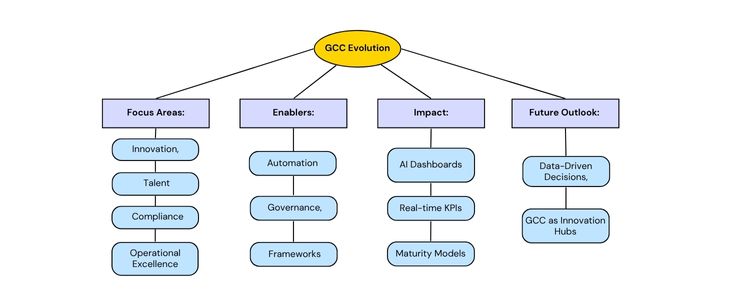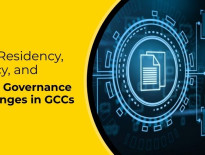
The Global Capacity Center (GCC) has developed as a powerful engine of innovation, digital changes, and global trade agility. The modern GCC, once seen as cost-mid-central centers, is now important for enterprise strategy—promoting revenue, adopting state-of-the-art technology, and providing housing to skilled global talents. India, as the world’s top GCC destination, hosts more than 1,800 GCCs, which contribute to global operations in banking, IT, retail, healthcare, and manufacturing. Microsoft, Target, and J.P. Companies like Morgan are taking advantage of global capability centers in India not only to save costs but also to run AI solutions, increase cybersecurity operations, and intensify the strategies of going to the market. But how will you measure the real success of modern GCC? It is no longer about how much money they save. The real question is, how much value are they generating? This new era requires a strategic roadmap for GCC, including new metrics and a focus on the widespread understanding of value and long-term change. Today, success means a well-aligned GCC that provides innovation, strengthens talent, enhances customer experience, and helps navigate complex risks—all of this while remaining financially strong. In this blog, we will find out how to redefine the success of GCC using modern, data-operated, and value-focused display models.
Traditionally, GCC handled IT assistance, human resource processing, or financial operations. But in the last decade, companies have invested in converting these centers into strategic centers for: This digital transformation in the GCC reflects changes that now play a direct role in revenue creation, product differentiation, and customer experience growth. India is currently a favorite destination, where more than 40% of new GCC setups are happening here in APAC (Nasscom).
A powerful strategic roadmap for GCC includes these 8 important points, which are beyond the cost metric: 1. Financial Performance and Price Receipt Instead of measuring only how much you save, now you should ask: Example: Suppose your GCC AI focuses on development and process automation. You can measure: Innovation velocity: 2. Operations Excellence and Frequency The GCC is now expected to have a fit, standardized, and high-quality delivery engine. Operating agility index may include SLA compliance, cycle time, and metrics such as throughput. 3. Talent and Human Capital Development Your GCC talent should focus on strategy: India’s technical GCC has an average attrition rate of about 18%, which makes employee engagement a top priority. 4. Innovation and Digital Change Effects It is the center of global capacity center transformation. Success is not only measured by thoughts but also measured from: Many GCCs have become testing sites for emerging technology before rolling out globally. 5. Strategic Alignment and Governance The GCC should now reflect the goals of its original company. Strategic alignment ensures that the GCC is not isolated but fully integrated into the core enterprise strategy. 6. Customer and Stakeholder Satisfaction Whether internal (IT, HR) or external (client-facing services), satisfaction is important. High first contact solution (FCR) and NET Promoter Score (NPS) indicate a strong service culture. 7. Risk Management and Compliance A modern GCC handles: The multi-regional GCC helped preserve companies during the Covid-19 lockdown due to its commercial continuity plan. 8. Environment, Social, Government (ESG) Contribution Sustainability is now an integral part. High-performing GCC focuses on this: ESG initiatives improve employer branding and reduce long-term risk.
Today’s GCC offers a wide range of business-capable services. Here are some major service sectors:
The report emphasizes a vital shift: “Impact Over Efficiency”. Below are examples of how KPI thinking is changing:
To create a strong measurement system, companies should use a layered mixture of structures: 1. Balanced Scorecard (BSC) 2. Benchmarking against Industry Colleagues 3. Maturity Model 4. ITIL and COBIT (for Tech GCC) 5. Data Analytics AI-operated Dashboard 6. Customer’s Voice (VOC) Program 7. GCC-specific OKR (Objective and Key Results)
GCC will soon be evaluated not only on the basis of what they provide, but also on the basis of how they shape the future of the enterprise: AI is not just a device—it is now a performance multiplier for GCC.
Some common obstacles and how to address them:
The role of global capacity centers is no longer limited to reducing operating costs—they are catalysts for enterprise-wide growth, innovation, and flexibility. To take full advantage of their power, organizations must change the value-focused strategy from the point of view of transactions. GCC can become long-term assets by adopting advanced measurement structures, investing in the right talent, and adopting the AI-operated insight that develops continuously with business needs. Companies that make GCC services as models will not only see performance improvement but will also get a durable strategic benefit in today’s dynamic global market.
Companies adopting this holistic approach to GCC’s success will unlock the rapid digital changes, high ROI, and strong competitive edge. To get more information about this topic, you may visit the detailed report.
The GCC cost-run back-office hubs have been converted into innovative-operated strategic centers, which enable AI, automation, and digital changes. Because modern GCCs add values through innovation, agility, talent development, and professional effects—not only by reducing expenses. Important KPIs include ROI, innovation velocity, automation effects, talent skills index, digital maturity,, and stake satisfaction. Digital change helps the GCC to automatically promote processes, promote innovation, and improve service distribution using AI, cloud, and data analytics. By investing in AI, by setting value-focused KPIs, aligning GCC with main commercial goals, and creating a tight, innovative operational model. Aditi, with a strong background in forensic science and biotechnology, brings an innovative scientific perspective to her work. Her expertise spans research, analytics, and strategic advisory in consulting and GCC environments. She has published numerous research papers and articles. A versatile writer in both technical and creative domains, Aditi excels at translating complex subjects into compelling insights. Which she aligns seamlessly with consulting, advisory domain, and GCC operations. Her ability to bridge science, business, and storytelling positions her as a strategic thinker who can drive data-informed decision-making.
GCC Change: From Aid Centers to Strategic Engines
A New Strategic Roadmap for GCC

Understanding Modern GCC Services
KPIs That Actually Matter: A Detailed Comparison Table
Traditional KPI
Modern KPI (Value-Focused)
Why It Matters
Headcount
Talent Skill Index
Measures how many employees are trained in future-critical areas like AI, cybersecurity, etc.
Cost Savings
Value Realization Score
Mixes cost reductions with qualitative outcomes like agility, innovation, and speed to market.
SLA Adherence
Innovation Velocity
Tracks how quickly an idea moves from design to launch, reflecting competitiveness.
Attrition Rate
Leadership Development Pipeline
Ensures long-term bench strength and reduced turnover among high performers.
Process Time
Automation ROI
Shows tangible returns on automated workflows (manual hours saved, cost reduction).
Revenue Growth
Business Outcome Attribution
Links GCC work (e.g., AI-driven personalization) to actual revenue lift or conversion increase
Internal Surveys
Stakeholder NPS (Net Promoter Score)
Indicates how likely business teams are to recommend GCC services across the enterprise.
Project Completion Rate
Digital Maturity Index
Assesses how far digital capabilities have evolved (e.g., use of AI, cloud adoption).
Employee Retention
Career Mobility Rate
Tracks whether talent is advancing internally or staying engaged with growth opportunities.
Infrastructure Cost Savings
Sustainability Impact Score
Measures ESG contributions like energy savings, DEI participation, and community programs.
Measurement Framework
AI and Data Analytics: Future of Performance Adaptation
Overcome the GCC Challenges
Conclusion
“GLOBAL CAPABILITY CENTER 3.0: Success: Pillars, Parameters, and Strategic Action.”
frequently asked questions (FAQs)

Aditi
Hey, like this? Why not share it with a buddy?
Related Posts
Recent Blog / Post
- The Green GCC Framework: Carbon Neutral by Design December 11, 2025
- Data Residency, Privacy, and Global Governance Challenges in GCCs December 11, 2025
- Applying Zero-Based Budgeting (ZBB) for Next-Gen GCC Cost Optimisation. December 10, 2025
- The Silent Crisis: Strategic Plays for Captive Centers to Avoid the ‘Year Three Plateau’ December 10, 2025
- Why Emotional Intelligence Is a Must-Have Competency in GCC Leaders December 10, 2025
- Bridging the Trust Gap: Unlocking European GCC Potential in India December 10, 2025
- The Telecom GCC Innovation Centre’s Role in Global 5G/6G Network Virtualisation. December 8, 2025
- Managing ITAR and Export Controls: The High-Security Mandate for Defence Captive Centers December 8, 2025
- Policy and the Multi-City GCC Grid: Catalyzing India’s Next Wave of Global Capability December 6, 2025
- BFSI GCC Digital Transformation: Moving from Back Office to Front-Line FinTech Innovation. December 6, 2025
- Pharma Global Capability Centers: Accelerating Drug Discovery with Computational Chemistry December 6, 2025
- ‘Capability’ and ‘Sustainability’ as the New Twin Drivers of GCC 3.0 December 4, 2025
- Beyond Cost: Using Value-Per-Employee (VPE) as the New Metric for GCC Cost Optimisation. December 3, 2025
- From Cost Arbitrage to Global Chip Architect: Securing India’s Tech Future December 2, 2025
- The Great Reskilling Challenge: Preparing the Workforce for GCC Digital Transformation by 2025 December 2, 2025
















